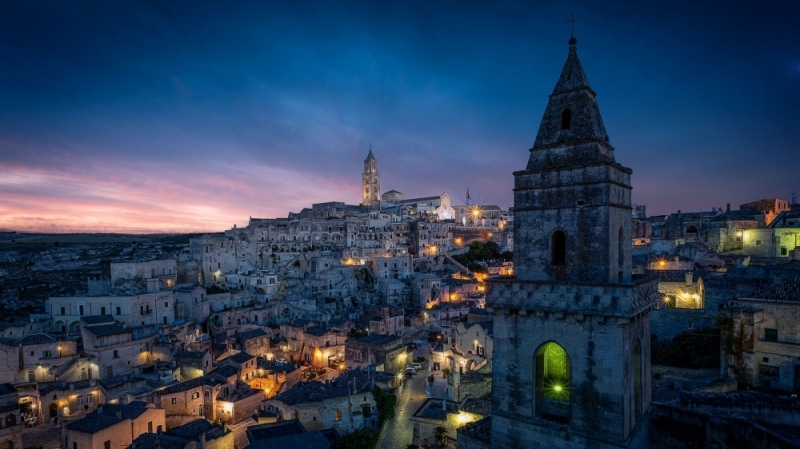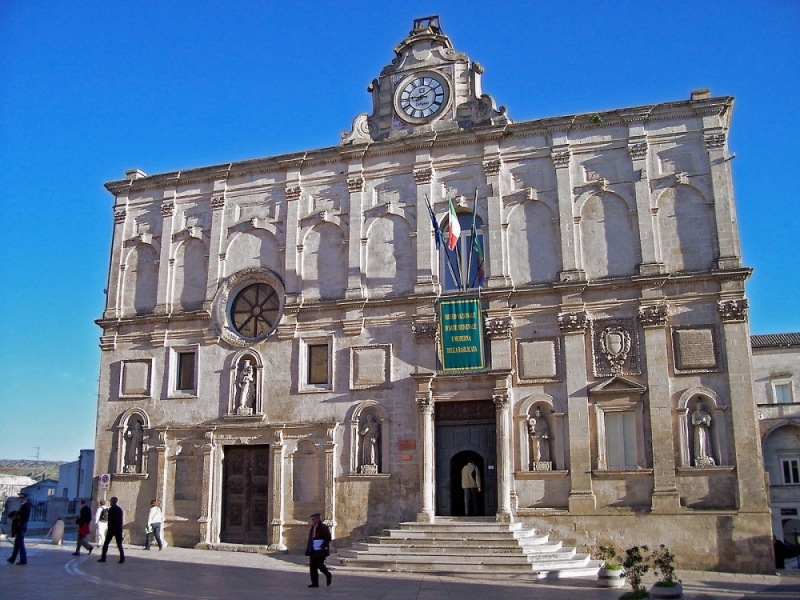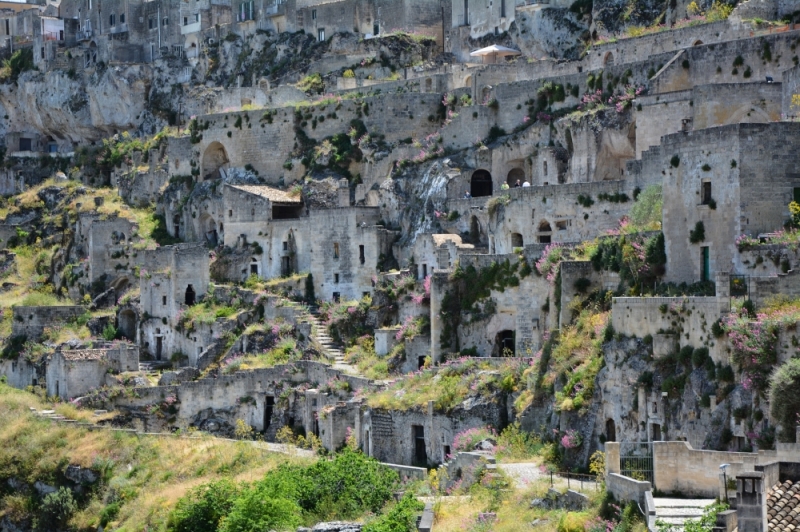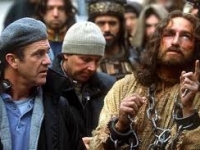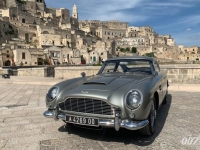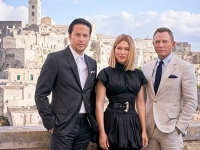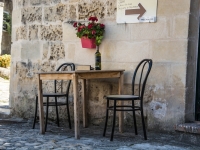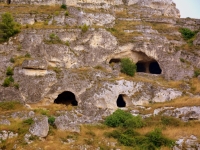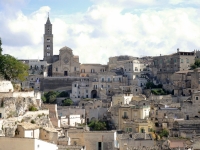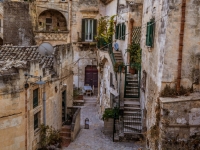The "Sassi di Matera" UNESCO World Heritage Site
Matera is a small jewel of southern Italy, which has not changed with the passage of time, so much so that in 2019 it was elected "UNESCO World Heritage Site and European Capital of Culture for 2019". Also called "The city of Sassi", Matera is the capital of the Basilicata region. It is located in the Murgia, a plateau where rock predominates. The historical settlements were near the Gravina Torrent, a watercourse that originates in Puglia and flows into the Bradano, which over time has carved into the rock. The typical rock of the area is "tuff" and over time man has been able to work it, creating churches and homes. According to history, Matera has been inhabited since the Paleolithic. During the Hellenic age it was dominated by the populations of Magna Graecia. The origins probably date back to the consulate of Metella (3rd century BC) who called it Metheola. Subsequently it was dominated by the Lombards and was annexed to the Duchy of Benevento. During the 7th and 8th centuries it is documented that Benedictine and Greek Orthodox communities settled in the caves. The 9th and 10th centuries were characterized by fights between the Saracens and Byzantines and by the German emperors, including Ludwig II, who attempted to chase them away, but destroyed the city. From 1043, Matera was governed by Count Guglielmo Bracci di Ferro. Subsequently Matera had a brief municipal phase, to then be governed by the Tramontano counts. In 1514 Count Giovanni Carlo Tramontano was killed during a popular revolt. The city passed into the hands of the Orsini family, until it became the provincial capital in 1927.
The history of Matera is interesting and at the same time full of adversities, in fact it was terribly poor, and had among the highest infant mortality rates. In the Sassi districts the inhabitants lived in caves together with the animals, in less than optimal conditions. It was initially Carlo Levi, with his work "Christ Stopped at Eboli", who raised the controversy regarding the conditions of the inhabitants of Matera. Later it was Togliatti, leader of the communist party, who denounced the backwardness of the city, calling it "national shame", until the Prime Minister De Gasperi signed the special law for the removal of the stones in 1952. Thanks to a redevelopment process, Matera became a UNESCO World Heritage Site in 1993. From "national shame" it has transformed into a cultural destination thanks to the museums, exhibitions in the Sassi, villages and rock churches.
What see
Visiting Matera means discovering the traces of a past still visible today. Living the city, it is possible to know, as Carlo Levi said, its aching beauty.
Borgo Antico and San Pietro Barisano church
For Primo, beautiful, to walk all around, is the ancient Borgo, where you can visit the Sasso Caveoso and the Sasso Barisano. Between the two there is the rocky spur of the Civita, where you can visit the noble palaces and the Cathedral of Matera. The Sasso Caveoso, rich in cave dwellings conceals the secrets of the city, while the Sasso Barisano represents the ancient site where merchants 'and artisans' shops resided. The Church of San Francesco d'Assisi is a masterpiece in the late Baroque style. It was designed by Vito Valentino and Tommaso Pennetta and stands out in the Piazza di San Francesco. It was built on the ancient church of the Saints Pietro and Paolo, which can be accessed through a trap door. Inside there is a fresco depicting the visit of Pope Urban II to Matera in 1903. The church was built in the thirteenth century but reached its peak in the eighteenth century. According to some the church was visited by the same Francesco D'Assisi in 1218, when he was visiting Matera. Another church not to be missed is the Church of San Pietro Barisano , which is the largest of the rock churches in Matera. Inside there are three naves and some frescoes have kept the brilliance of their original colors. Visiting the Ridola Museum you can make a real journey through history. The latter was created in 1922 on the orders of Domenico Ridola and is located in the convent of Santa Chiara.
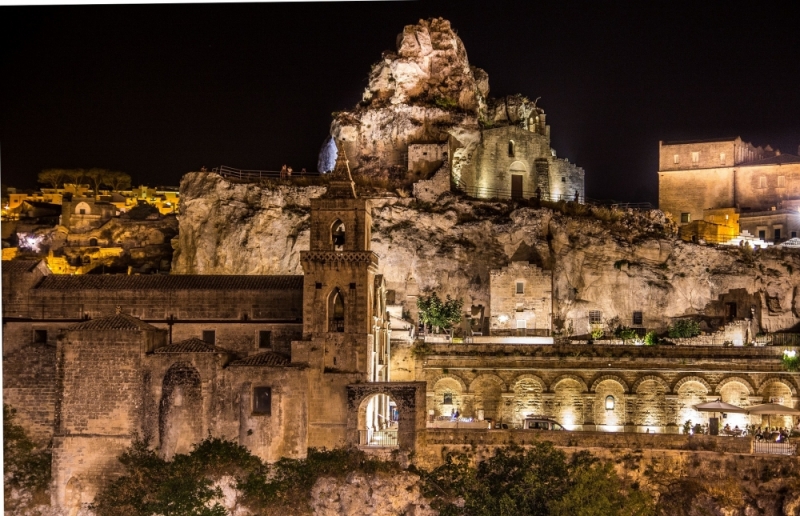
Sassi di Matera - Cathedral of the Madonna della Bruna and Sant'Eustachio
Image by chatst2 from Pixabay
Image by chatst2 from Pixabay
Cathedral
On the highest spur of the Civita, which divides the 2 stones, stands the Cathedral of the Madonna della Bruna and Sant'Eustachio. Built in the Apulian Romanesque style between 1230 and 1270 where the Benedictine monastery of Sant'Eustachio, protector of the city, stood where Pope Urban II stayed between 1093 and 1094. The outside, Unlike the interior, it preserves its original shape almost intact. The façade is dominated by the rose window with sixteen rays, surmounted by the archangel Michael. At the center of the facade there is the main door, closed by an arch and the Madonna della Bruna in the lunette. On the sides of the door there are statues of Saints Peter and Paul. The interior is a Latin cross and has three naves. It has undergone considerable transformations since 1627 with the addition of stuccos and decorations. Very beautiful the hard stone crib made by sculptors Altobello Persio and Sannazzaro of Alessano between 1530 and 1534. The main altar restored in 1627 is dominated by the large altarpiece executed by Fabrizio Santafede depicting the Virgin surrounded by Saints. In the apse there is the valuable wooden choir in solid walnut carved in 1453 by Giovanni Tantino di Ariano Irpino, divided into 60 stalls.
Palazzo Lanfranchi
The Church of San Giovanni Battista , is a clear demonstration of medieval architecture. It is located near Piazza Vittorio Emanuele and Piazza San Rocco. The external façade is in Romanesque style, while inside you can admire Gothic art. Palazzo Lanfranchi has a baroque style facade that will certainly capture your attention. Since 2003 it has been the seat of the National Museum of Modern Art of Basilicata and today it is divided into 4 areas: Sacred Art, Collectibles, Contemporary Art and Demo-ethno-anthropology. On the ground floor you can admire "Lucania '61" by Carlo Levi, a work designed to honor the centenary of the Unification of Italy. The Church of Santa Maria di Idris is located inside the Sasso Caveoso, among the rocks of the Monterrone. It is a modest church, with a single nave and, according to legend, the women climbed the stairs of the church on their knees, during periods of drought, in order to call back the rain.
underground
The cave dwellings are an integral part of the history of Matera, among which there are those of Casalnuovo and Vico Solitario, where numerous families and animals lived. In Matera, part of the story is also contained in the basements . In fact there are about 1000 water cisterns. The most noteworthy is the one known as Palombaro Lungo, which depicts the engineering of those times. It is not recommended for those suffering from claustrophobia. If you love nature, don't miss the Parco della Murgia Materana . Having as a starting point Civita, you can get to the river by passing through rock churches and fantastic caves.
Movida and entertainment
When it comes to nightlife, Matera is not unprepared: the most frequented area is that of the Sassi district, and being the pedestrian area, it is possible to enter streets and alleys that will show you the night Matera. Being the city capital of culture, you will find among the events offered theatrical performances, concerts, exhibitions and much more. If you find yourself near the Sasso Barisano, take a walk in the blind alley Salsamenteria: a place born from the union of two caves, which will fascinate you thanks to its vintage decor. If, on the other hand, you want to sip a drink and accompany you with good music, you must try Shibuya. A cool place, where you can drink drinks in the company of celebrities, is Lucana Abundance. If you are walking towards Piazza del Sedile, you can take a tour of the Arturo, which is also very popular. In any case, by exploring the narrow streets of Matera, you can discover the locals that animate the city on your own.
Climate, curiosity and advice
Climate: The ideal season to visit Matera is Spring. In fact, the mild spring climate makes the excursions much more pleasant. Winter is cold, but we are still talking about a bearable cold, given that we are in the South. In summer, instead, you risk suffering the heat, even if, staying in the Matera stones, you can enjoy the cool.
Curiosity: The origin of the name Matera, is shrouded in mystery. According to some scholars, its origin is due to the Greek, while others say it derives from "Mataios olos" which means "all vacuous". Still others believe that the name Matera was born from the word Metèoron, which means "starry sky" in reference to the lights of the city, which in the late evening, make it look like a crib. There are many other theories about it, but what is certain is that the origin of the name Matera is still unknown today. It is known that Matera was dug out of the rock, but to demonstrate that the city was once covered by the sea, are the fossilized shells in the walls. A historical custom, which today has been lost, is that of the stamps of bread. In Matera, until the 1950s, each family prepared their own loaves and then cooked them in the city oven. In order to avoid misunderstandings, each family left a stamp on their own loaf, so as not to confuse it with others. Moreover, according to tradition, some Materans used to give a stamp to the girls, and this gesture meant asking them to help. If the stamp was rejected, the marriage proposal was refused. Both cinema and literature have honored this city: in fact it has been the location of famous films, such as Il Vangelo secondo Matteo by Pier Paolo Pasolini (1964), La passione di Cristo, directed by Mel Gibson (1994), 007 James Bond (2019 ) and many others. As mentioned above, Matera has not always been the capital of culture, but otherwise it has been a symbol of social decay in the past. The first to deal with the subject was Carlo Levi, who wrote "Christ stopped at Eboli", a book with which he denounced the conditions in which the caves were at the time.
Tips: If you are in Matera at the beginning of July, don't miss the feast of the Madonna della Bruna, a popular festival, deeply felt by the people of Matera.


